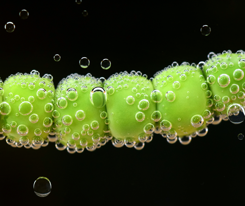The subject of the invention is a pVII protein with a point mutation of filamentous bacteriophage M13 and its use for specific binding of carbon nanomaterials, in particular carbon nanofibers. Carbon nanofibers with diameters in the range of 10-500 nm, due to their very good electrical conductivity, high porosity and developed active surface area, among other things, are used in electrochemistry as a material for electrode modification. Electrodes modified with nanofibers can be used for supercapacitors, fuel cells, lithium-ion batteries and electrochemical sensors. They can also serve as substrates for immobilizing bio-molecules such as DNA. Carbon nanofibers themselves can be used as hydrogen storage materials or biomaterials for creating specialized medical devices such as implants. For industrial applications, it is desirable to improve the electrical properties of nanofibers by developing their active surface. Viruses, particularly bacteriophages, are increasingly being used for this purpose.
The developed pVII protein with a point mutation of the filamentous bacteriophage M13 can be used to specifically bind carbon nanomaterials, enabling the creation of hybrid materials (bionanomaterials) with a more developed surface area, with increased efficiency compared to existing industrial solutions based on bacteriophages.
The use of carbon nanofibers in industry is economically efficient due to low production costs and simple manufacturing technology, and the improvement of the electrical properties of carbon nanofibers creates the possibility of expanding the areas of their use in various industries.

